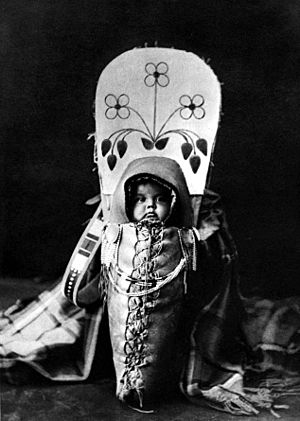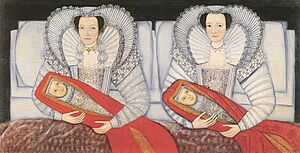Swaddling facts for kids
Swaddling is an old way of wrapping babies tightly in blankets or cloths. This keeps their arms and legs from moving around too much. Sometimes, special swaddling bands were used to make the wrap even tighter. This practice was very common for a long time but became less popular in the 1600s.
A Look Back: The History of Swaddling
People think swaddling might have started way back in the Stone Age. That's how old this practice is!
The first pictures we have of babies wrapped up like this are from Crete and Cyprus. These pictures are on special gifts given to gods (called votive offerings) and items buried with people (called grave goods). They are about 4,000 to 4,500 years old.
Small statues of babies in swaddling clothes have also been found in tombs. These were in the tombs of women from Ancient Greece and Rome who died during childbirth. People also found models of swaddled babies in special places dedicated to a god named Amphiaraus. It seems mothers often gave these as thank-you gifts when their babies got better after being sick.
One of the most famous stories about swaddling is from the New Testament in the Bible. It talks about the birth of Jesus:
And so it was, that, while they were there, the days were accomplished that she should be delivered. And she brought forth her firstborn son, and wrapped him in swaddling clothes and laid him in a manger; because there was no room for them in the inn.
The swaddling clothes mentioned in the Bible were cloths tied with bandage-like strips. After a baby was born, it was washed and rubbed with salt and oil. Then, it was wrapped tightly with these strips. People believed this kept the baby warm and helped its arms and legs grow straight.
During the Tudor period (around the 1500s and 1600s) in England, babies were wrapped from head to toe in linen bands. People thought this would help the baby grow without any physical problems. A special band was even attached to the baby's forehead and shoulders to keep the head secure. Babies were often swaddled like this until they were about 8 or 9 months old.
In the 1600s, ideas about swaddling started to change. A doctor named William Cadogan was one of the first to say that swaddling should be stopped completely.
By the 1700s, many thinkers and doctors began to disagree with swaddling. Even though it's not common in the Western world anymore, many cultures in Eastern countries and some tribal people still use it today.
Images for kids
-
Votive offerings showing swaddled babies from Agia Triada (Crete), from the Bronze Age, 2600-2000 BC. These are now in the Archeological Museum in Iraklion, Crete.
-
A swaddled baby and a "bad mother" in a painting from 1505–1510. This is a detail from The Temptation of St. Anthony by Hieronymus Bosch. It is in the Museu Nacional de Arte Antiga, Lisbon.
See also
- Babywearing
- Kangaroo care






